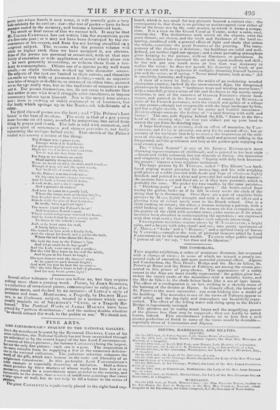FINE ARTS,
LORD FARNBOROUGH'S BEQUEST TO THE NATIONAL GALLERY.
SINCE the munificent bequest by the Reverend Ilotweti. CARR of his entire collection, the National Gallery has not been so enriched through one Individual as by the recent legacy of the late Lord FARNBOROUGH. It consists of fifteen pictures ; the famous CAN ALETTI being the largest, but not the only fine picture : each one is a gem. The acquisition is the more valuable from its supplying a few of the numerous deficien- cies in the national collection. The judicious selection enhances the worth of the gift, which does honour to the taste and liberality of an enlightened connoisseur. In this paiticular, Lord FARNBOROUGH'S Sable example is especially deserving of imitation. Half-a.dozen choice pictures by tho.,e masters of whose works we have few or no specime ns, would be a contribution more grateful to the country, and honourable to the donor, than a stoic of indifferent paintiegs that cover III■rge space of wall, but do not helPto till a hiatus in the series of Painters.
The great CANAL ETTI Is injudiciously placed in the right-hand cup- board, which is too small for any pictures beyond a cabinet size : the consequence is, that there is no getting an uninterrupted view either of this or the lesser one by the same master, to which it forms a compa- nion. It is a view on the Grand Canal at Venice, under a calm, cool, evening sky. The distinctness with which all the objects, even the most distant, are shown, and the truth and freshness of the local co- louring, combined with a general effect of light and shade that unites the whole, constitute the great beauties of the painting. The trans- parency of the shadows is delicious; the buildings are solid and well- defined, yet neither rigid nor opaque; and a clear pervading atmosphere gives keeping to the picture, without flimsiness or garishness. In short, the painter has exetcised his art with equal modesty and skill; he has not put one touch more or less than was necessary to realize the scene : he does not parade his dexterity of band, or put 3 our eyes out with an explosion of sunlight, thrusting himself between you and the scene, as if saying, " Never mind nature, look at me." All is simplicity, harmony, and repose. A view of a town in Italy, in the midst of an undulating wooded champaign country, backed by the snow-crested Alps, the foreground picturesquely breketi into " verdurous ways mid winding mossy lanes," with a waterfall, giving a sense of life and freshness to the serene, sunny seclusion, is one of the sweetest of GASPAR POUSSIN'S classic land- scapes, end painted in his freest manner. A sunset, by RUBENS—a piece of fat Flemish pasturage, with the church and gables of a village ill one corner—though not comparable with the large landscape by him, and but a slight sketch, is full of his gusto and fruitful luxuriance : RULENS always conveys the feeling of "a land flowing with milk and honey." The sun, just dipping behind the .hill, " flames in the fore- head of the evening sky," so that you almost put up your hand to screen the eye from its dazzling rays. A large landscape, at evening, with an effect of moonrise, by VAN- DERNEER, and OAP, is pleasing, not only for its natural effect, but on account of the incidents that help to convey the impression of' the still- ness of closing day,—such as the milk .maid and peasant talking in the foreground, and the gentleman and lady at the garden-gate enjoying Os cool evenirg air.
The " infant Samuel" is one of Sir JOSHUA REYNOLDS'S IDOSE charming representations of childhood; and is painted in his best style —broad and richly coloured, but not slovenly or skating: the innocence and simplicity of the kneeling child, " lisping with holy look his even- ing prayer," express a true religious sentiment. The large picture by D. TENIERS, called " The Misers "—a hard- faced griping usurer grasping his money-bag, and his wife weighing gold pieces at it table coveted with deeds and bags of silver—is highly finished, and painted in a clear and powerful but cold and dry manner : the persons have a set and fixed air, as it they were portraits, which is probably the case. We prefer the two smaller, by the same painter— a " Drinkingliarty " and a " Music-party:' the bottle-nosed boor timing the guitar, looks as if he felt in every ma ve the click of the string that he is thrumming. Over these are a pair of exquisite little pioures by 111,xEs, highly wrought mul with a breadth of effict and a glowing tone of colour rarely seen in the Dutch school. One is a child rocking an intimt ; the other, a woman scraping a parsnip, with a child looking on : the intentness of the woman on her occupation, and the gravity of the child with pendant arms, (who seems as if its whole faculties were absorbed in contemplating the operation,) are expressed with that vital reality that ahme makes such subjects interesting.
Two exquisite miniature marine pieces by W. N'ANDEVELDE, a bright calm, and a breeze with inky clouds and sea ; two pretty specimens of F. Mol.a, a" Leda" and a " Repose ; " and a spirited study of horses by VANnver.,—complete the sum of pictorial treasure added by Lord FARNEOROUGH to the national wealth. To every other public.spirited " patron of art" we say, " Go thou and do likewise."


























 Previous page
Previous page